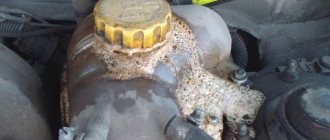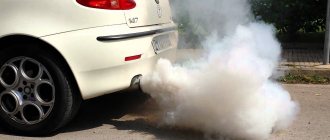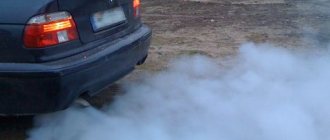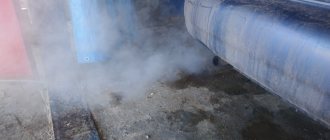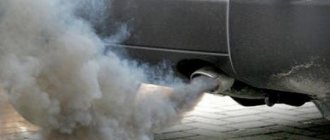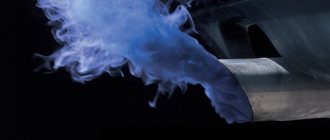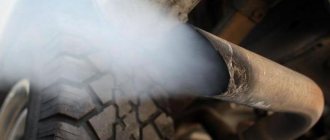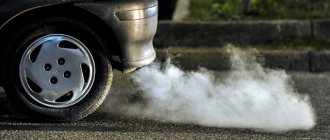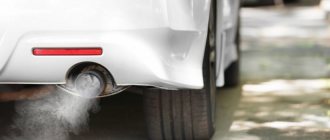Good day to all car enthusiasts! Winter. It's a wonderful time. It just so happens that most problems and breakdowns of cars happen during this period. Moreover, sometimes we may not even notice signs of emerging problems. For example, when steam comes out of the exhaust pipe on a warm engine.
Often motorists ignore these symptoms. And indeed, in winter there is nothing surprising in a couple. It's cold outside, very humid, hence the evaporation.
But white smoke, which is often called simply steam, is not always so harmless. After all, this can happen in the summer, and then there are even more questions.
Well, let's see why such a picture can be observed in summer, winter, cold weather or rain. What does it potentially mean, when is it dangerous, and in what situations should you not be afraid. Let’s look separately at the operation of diesel and gasoline engines with the indicated symptom.
To be afraid or not
To begin with, I propose to understand the main points. Here it is important to distinguish when steam really poses a potential threat, that is, it indicates a malfunction, and when there is absolutely nothing to be afraid of.
If we are talking about absolutely safe and harmless smoke, then it should be white, have no odor and no traces of impurities. When the situation develops this way, we are talking about water vapor. Condensation has formed in the exhaust system, that is, a fairly large amount of moisture has accumulated. Now this water begins to actively evaporate due to gradual heating. It all turns into steam. It is in steam that this is important to remember. Because there is another concept. I'm talking about white smoke.
If we see such a picture when white smoke comes out of the exhaust, then it makes sense to suspect the engine or cooling system of some kind of malfunction.
During normal engine operation, the smoke coming out of the chimney should be transparent or close to it. However, on older cars and rather worn-out engines, the smoke becomes more toxic and dirtier.
What's the result?
Do not forget that some cars do not have a catalyst, and this entails additional pollution, since the exhaust gases skip the pre-treatment stage before exiting.
If this element is present, then checking the catalyst for clogging will be your first priority.
Let's sum up the intermediate results. If white smoke is coming out of your car's exhaust pipe, this indicates high levels of moisture inside the exhaust system. It is important to pay close attention to this nuance. When the engine warms up, all the water should evaporate. Therefore, steam and condensate no longer come out of the pipe. But if the engine has warmed up and smoke continues to pour out, then this is an obvious sign of a problem. Something needs to be done. First, find out the reasons.
There are several possible reasons for this situation.
Let's look at them, and take a separate look at the features of diesel and gasoline internal combustion engines.
White smoke in cold weather
Let's start with the fact that the appearance of white smoke does not always indicate any breakdown. As we said just above, there is water vapor in the exhaust and there is no way to get rid of it, because it is in the air, which enters the engine along with the air when creating the fuel mixture. In cold weather, hot steam leaves the muffler along with exhaust gases, instantly cooling and turning the exhaust white.
That is why, at sub-zero temperatures, car exhaust gases strongly resemble white smoke. This happens due to the rapid cooling of hot steam coming out of the car muffler. Moreover, the lower the temperature, the thicker and whiter the exhaust pipe will smoke.
Possible reasons
You should not think that this problem is relevant only for owners of cars such as VAZ 2115, VAZ 2105 and old foreign cars.
In fact, this can happen to any motorist who has white smoke constantly pouring out of the muffler. And not only at startup and gradual warm-up, but also at high speeds.
Most often this is due to:
- presence of moisture in the exhaust;
- presence of water in fuel;
- malfunction of the injection system;
- incomplete combustion of fuel;
- penetration of coolant into the engine;
- natural wear and tear of some components;
- untimely replacement of parts and consumables;
- low quality components, etc.
Some people notice that the smoke is quite smelly, sometimes with the smell of gasoline. For others, the coolant is suspected, although the antifreeze does not go away.
To better understand the issue, you should take a separate look at diesel and gasoline internal combustion engines, since certain reasons for them have slightly different origins.
Air filter clogged
Indirectly, white smoke from the exhaust pipe on a warm engine may also indicate a clogged air filter. This reason is much less common, but it should not be discounted. If the air filter is clogged to such an extent that air is not able to pass through it in the required volume, then this will result in serious disturbances in mixture formation.
When the fuel mixture is formed, more gasoline and less air will be used. The percentage of smoke will increase greatly, and in some cases the unit will emit white smoke. This problem can be corrected quite simply by simply replacing the air filter.
I am often asked about car emissions. Often, newbies, and even experienced drivers, do not like the way the car “smoke”. More precisely, sometimes white smoke comes out of the exhaust pipe; it can appear both in the morning (when the engine has just been started) and during the day. And there are two different reasons. But everything is in order...
CONTENTS OF THE ARTICLE
Guys, I want to write several articles that will be devoted to smoke from the muffler, because different colors can mean different malfunctions of your engine, so be sure to take a closer look! Today is the first part, we will talk specifically about white exhaust. Read about black here .
Diesel internal combustion engines
Let me remind you that during gradual warming up, the release of white smoke (steam) from the chimney of a diesel car engine, as well as a gasoline one, is the norm.
But when the engine reaches operating temperature and smoke continues to pour out, then there are clearly problems.
They may be related to:
Everything about car operation
(Smoke from the exhaust - causes and methods of troubleshooting) | Site search |
Content:
1) Whitish/transparent smoke from the exhaust pipe
2) Black smoke from the exhaust pipe
3) Bluish smoke from the exhaust pipe.
4) White smoke from the exhaust pipe
From time to time, any engine (even a new one) smokes, so every car owner sooner or later asks himself the question - “why does the engine smoke?”
There is an opinion among motorists that by the color of the smoke from the exhaust pipe one can determine which engine malfunction is causing it.
Let us first consider this issue in general terms, and then we will analyze each specific case in more detail and make this visual malfunction point us to more serious defects hidden from view, i.e. We can determine the condition of the car engine by the color of the exhaust.
In general terms, the question of why a car smokes can be answered like this:
1) Whitish / transparent smoke from the exhaust pipe - water from the muffler
This is normal when the engine is running cold or when working in cold weather.
The oxidation of any carbon fuel ideally produces CO2 and H2O. If CO2 comes out of the engine in the form of a transparent gas, then H2O comes out in the form of superheated steam and, as it cools, turns into a liquid state. It is the condensed water vapor that we observe in the form of smoke from the exhaust pipe.
It is quite easy to verify that water vapor is always present in the exhaust (even when it is transparent and we cannot see it) by a simple experiment: cool a saucepan (or any other dish) and place it under the exhaust pipe of a running engine.
And you will be able to observe how steam from the exhaust gases will condense on the cold walls.
At the beginning of the engine operation, until both it and the exhaust system have warmed up, you can even see dripping from the muffler. In this case, the release system itself plays the role of cold dishes.
It should be noted that water vapor dissipates quite quickly after leaving the exhaust pipe and does not smell of anything. Read more…
2) Black smoke from the exhaust pipe
similar to what loaded old trucks traveling uphill spew out of their depths (I think this picture is familiar to everyone) is the brainchild of soot.
This is exactly the kind of smoke coming out of the tractor mufflers that you can see in the photo in the header of the page.
In passenger cars, black smoke from the exhaust pipe appears mainly when there is a sharp increase in load, or when driving with a high load. Even logically, it can be determined that the cause is poor mixture formation (mixture over-enriched in fuel). Like any deviation in mixture formation, this leads to excessive fuel consumption. Well, the fuel equipment or the engine control system need to be repaired accordingly. Read more…
3) Bluish smoke from the exhaust pipe.
Here we can draw an analogy with two-stroke motorcycles - everyone has seen what happens when a motorcyclist adds an excess amount of oil to the fuel (whoever has not seen a motorcycle may remember a chainsaw or other device with a two-stroke engine), the exhaust in this case smells of burnt oil. Thick clouds of bluish engine smoke flying out of the exhaust pipe, and dissipating for quite a long time. The same thing happens in a car, in which excess oil gets into the cylinders for some reason. Of course, the density and amount of smoke greatly depends on the operating mode of the engine, as well as on the degree of warming up, idle time and other factors.
It should be noted that the degree of bluishness of this smoke is quite weak, it is somewhat similar to ordinary steam, but the smell of oil and traces on white paper (+ oil consumption) should help you orient yourself.
In this case, you need to look at the engine hardware itself. Read more…
4) White smoke from the exhaust pipe - water from the muffler
The case is similar to that described in the first paragraph, but is thicker and does not disappear completely when the engine warms up in the warm season.
In addition to oil, coolant can also get into the engine cylinders. It is this that, when condensed, turns into white vapor, which dissipates relatively quickly in the air. But there is a small but: liquids with different properties and structure are used as a cooling liquid. For this reason, the vapor may differ from pure white in color and thus mislead the owner. To be more sure, you need to pay attention to the coolant flow. The engine hardware and cooling system are subject to repair. Read more…
If we consider the essence of this problem in more detail, it turns out that in real life not everything is so simple. Usually, an engine malfunction is complex in nature, and it is all the more frivolous to start a repair based only on the color of the smoke from the exhaust pipe without checking your assumptions with additional methods.
To accurately diagnose the condition of the engine, you will have to roll up your sleeves and carry out more complex diagnostics.
1) Transparent steam.
It doesn’t require any explanation or repair, it’s just worth noting - be careful when you put the car in automatic mode in winter based on the temperature - the exhaust pipe may simply become clogged with ice and the car won’t start.
As a rule, steaming appears either in the cold season or in humid weather. The dynamics are as follows: when you start the engine, a barely noticeable hovering is visible, as it warms up, the hovering intensifies. When driving a vehicle with a cold engine, droplets of liquid may drip from the exhaust pipe. As a rule, when the engine warms up completely, the hovering either completely disappears or decreases. It is worth keeping in mind that not only the operating temperature of the engine matters, but also the temperature of the entire exhaust system.
2) Black smoke from the exhaust
usually caused by lack of air (or excess fuel). Accordingly, solutions to the problem based on this:
The most shameful case is a clogged air filter (especially harmful for carburetor, gas and diesel engines).
Next, you need to look at the compression - with “leaky” cylinders, the combustion process deviates from the calculated one and does not produce the desired result (the required power), as a result of which the ECU can over-enrich the mixture, regardless of its full serviceability.
We look at the fuel pressure and fuel correction - a situation is possible when the fuel system is contaminated and the fuel pressure is low, which leads to prolonged and untimely injection of fuel into the cylinders. Or it is possible that the injectors do not close completely and “flow”, which leads to very poor fuel consumption, a decrease in power and sometimes even water hammer (fuel accumulated in the manifold flows into the cylinder and leads to breakdown).
Engine monitoring sensors can also give erroneous readings, resulting in the ECU operating “blindly”. As a rule, in this case the “check engine” light comes on. However, in some models this light does not always light up if there is a malfunction of any engine. You can read more about engine control systems here.
All described cases are accompanied by the formation of black carbon deposits on the spark plugs, increased fuel consumption, decreased engine performance, increased wear of the CPG (gasoline washes away the oil film from the cylinders), shots are possible in the muffler and there is often a smell of gasoline from smoke from the exhaust pipe.
Spark plugs can help diagnose the problem. When there is black smoke from the exhaust pipe, the spark plugs usually have a soot-black coating.
That is, when analyzing smoke from the exhaust pipe, it is advisable to analyze the condition of the spark plugs.
In any case, driving this way is not only not environmentally friendly, but also expensive, and measures must be taken.
3) Bluish smoke from the exhaust pipe.
The most typical situation that I have encountered on some of my cars is clouds of smoke in the first 10-30 seconds after starting the engine. The defect progresses with increasing mileage and decreasing outside temperature. You start the engine and see a cloud of bluish oil smoke in the rearview mirror. Of course, you are tense, and bad thoughts about expensive repairs come to mind. But at the end of the journey everything becomes normal. Of course, repairs are postponed.
As already written earlier, the reason is a large amount of oil that got into the cylinders or exhaust tract. In our case, oil enters the cylinders during parking through loose (hardened) valve stem seals. At this point, you will most likely have some difficulty starting the engine due to oil deposits on the spark plug electrodes.
But blue smoke can appear not only after a cold start of the engine, but also while driving. Moreover, it happens that smoke appears when coasting (when the throttle is closed) or under load, etc. If smoke appears while coasting, the reason for this will be the CPG: at this moment a vacuum is formed in the cylinders and through a loose friction pair, the piston ring cylinder, oil mist from the crankcase is sucked into the hot cylinder
The most common causes of blue smoke are described below:
a) Worn or hardened valve stem seals.
The malfunction gradually increases and manifests itself in the form of a large emission of smoke at the first moment after starting, then gradually the intensity of the smoke decreases (as it warms up). This is due to the softening of the caps as they warm up. Accelerated wear of the caps can be caused by increased clearance in the valve bushings, poor quality of the caps, or a large amount of crankcase gases (due to wear of the CPG).
The quality of the valve stem seals themselves is also of great importance. Unfortunately, I encountered this personally:
The photo shows two different caps working under the same conditions. And if the left cap was already hardened (the car smoked shamelessly and ate about a liter of oil per 1000 km), then the right one looks like new after 50k. work. The name of the good one is RoadSafe, and the name of the bad one is incognito, because... Most likely it is counterfeit and I don’t want to cast a shadow on the Mitsubishi brand.
In this case, the oil will enter through a leaky connection between the valve body and the seat (sealed by the MSC). And it will enter both the intake (if the valve is closed when parked), and the cylinder (if the valve is open), or even into the exhaust manifold through the exhaust valve bushings. Excessive smoking in the first moments will be caused by the combustion of all the oil that has flowed into the cylinders from the cylinder head during the period of inactivity and the low elasticity of the cold rubber of the valve stem seals.
b) Worn or stuck oil scraper rings.
In this case, the oil film is not removed by specially designed rings and an excessive amount of oil enters the cylinders. Perhaps this is the reason why the engine can consume the greatest amount of oil. At the first stage, decoking of the rings can help. But after this you need to pay more attention to the engine, because... this may mean the rings lose their spring properties and will soon re-occur. The method for checking piston rings is described on the page on measuring compression in the engine, so I will not repeat it.
I’ll just add that diagnostics is difficult if only the oil scraper (lower) rings are stuck, because The compression is nominal, and decarbonization does not help due to the good condition of the upper rings. A similar option is pictured below:
c) Turbine malfunction.
Cars equipped with turbochargers, if the latter is in poor condition, can smoke due to oil being thrown into the turbine. In this case, the oil used to lubricate the turbine bearings is thrown into the intake tract through faulty seals (usually turbine shaft seals):
This is quite easy to diagnose. It is enough to remove the air duct running from the turbine to the engine at the lowest point and look to see if there is any oil inside. Or (in the early stages) a white light fabric is stretched into the pipe in front of the throttle, then the pipe is placed. Then we gas and remove our fabric. Traces of oil will indicate an emerging turbine malfunction.
d) Clogged crankcase gas recirculation system.
Car engines are built in such a way that a slight vacuum must be maintained inside the engine. This vacuum is created either by a vacuum in the throttle area, or by special vacuum pumps (much less often). In any case, the pumped-out crankcase gases are discharged into the intake manifold. But there are no clean gases in the crankcase, but only oil mist. Because of this, these gases must be separated from them before being discharged into the intake manifold. This is exactly what the crankcase gas recirculation system does. When it fails, crankcase gases throw oil droplets into the intake, which is why the engine can also produce characteristic “oily” smoke.
d) Wear of the CPG (cylinder-piston group).
A special case of point “d” is wear of the cylinder-piston group (or the occurrence of rings, including compression ones). If the oil scraper rings are not stuck, but there is simply increased wear in the friction pairs.
This will result in an increased amount of exhaust gases entering the crankcase. Those. the amount of gas passing through the recirculation system will significantly exceed the calculated one. Of course, drops of oil will leak into the intake and the result will be the same as in point “d”. The malfunction can be identified by opening the oil filler neck with the engine idling. With a working CPG and crankcase gas recirculation system, air will be sucked into the neck (you can check with a piece of paper), or slightly come out of it. If crankcase gases are knocked out of the neck with noticeable force, you should think about serious repairs. It is also worth paying attention to the color of the gases coming out of the oil filler neck - ideally they are colorless.
You can check your assumptions about CPG wear by measuring compression. First, we measure the compression, then pour a little oil into the suspicious cylinder and take another measurement. Details are described here
f) Bad oil.
Don't discount bad oil either. Moreover, several options are possible here. Firstly, you could simply buy a counterfeit. In this case, the properties of the oil are one... known. And how this oil will be separated in the crankcase gas recirculation system and how it will withstand high temperatures in the cylinder is not known:
Secondly, you could simply overheat the oil. The fact is that motor oil loses its properties when the permissible temperature is exceeded. Athletes know about this and install engine oil temperature sensors, additional oil coolers, etc. There is nothing like this in a regular car. And the car itself is not designed for extreme loads. And the pistons are cooled from the bottom by engine oil! In ordinary life, the supply is quite enough. But imagine on a hot summer day you are going on vacation: you have loaded up your family and things (that is, full load by weight), you have engine protection (which interferes with normal cooling of the oil in the crankcase) - where in Russia would you be without it? Plus, there was a long climb on the way and... voila, the oil was overheated. It should be changed without question.
g) The birthmark of many 16-valve engines is deep spark plug wells.
These wells have several joints of mating parts. One by oil, the other by air. The result of a certain set of circumstances will be oil from the well entering the engine suction:
Well, engine smoking is the end result. It’s not difficult to check this - take out the spark plug tips and if they are covered in oil, then your spark plug well installation is no longer doing its job. If we add to this the leakage of the intake manifold, the situation described above will result.
h) Original.
In addition to the described malfunctions that cause engine smoke, there are a number of rather exotic and even curious ones. For example: engine smoking (oil smoke) can be caused by a microcrack in the engine (quite difficult to determine) through which oil enters the intake or directly into the cylinder, or an oil leak and contact with exhaust system elements.
Curious cases include cases when a car owner accidentally pours fuel intended for two-stroke engines (mixed with oil) into the tank and then, in a panic, looks for the cause of the engine smoking.
4) The engine smokes with clouds of steam.
Here the reason is quite clear - water gets into the cylinders. Its location is clearly the engine cooling system. This means that it is quite simple to determine this by reducing the level of antifreeze. In addition, for a more accurate diagnosis, it is necessary to examine the candles. In a cylinder where there is water, the spark plugs will have a deposit of scale on the electrode, which is quite easy to notice. Try to clean such a candle with a file and you will be able to see a deposit similar to the deposit inside a kitchen kettle.
In this case, there are two main reasons - the head gasket has broken, or there is a microcrack in the cylinder. Again, the reason for this is either incorrect assembly, or poor-quality spare parts, or OVERHEATING of the engine (of course, there are others, but these are the main ones). In any case, repairs cannot be delayed.
Sometimes the reason for liquid getting into the cylinders can be corrosion of the engine from the inside (through!). This is the picture I had the misfortune to see on one of my cars:
Poor quality antifreeze literally ate half the block from the inside. Corrosion products (simply rust) even filled the expansion tank. The result is junk. It is more expensive to restore such an engine.
Under bad circumstances, coolant can get not only into the cylinders, but also into the oil! This can be easily determined by examining the oil level dipstick.
You will not confuse the emulsion with anything else. There’s really no point in delaying this. In this case, before repairing, I would advise flushing the inside of the engine with diesel fuel. This will help save time and nerves during repairs; in addition, in a clean engine it will be easier to find the location of the fault.
If such a disaster has not happened yet, and you, knowing about this danger, are at a loss: is it time to change the coolant?, what kind of antifreeze to fill in? -I advise you to spend a couple of minutes and read the article “how to check antifreeze.”
Good luck and all the best to you.
Key words: The engine smokes, why the engine smokes, the engine smokes with black smoke, the engine smokes with white smoke, the engine smokes with bluish smoke, water from the exhaust, the car smokes.
The best way to degrease metal before painting at home
- condensate in diesel fuel;
- incomplete combustion of diesel fuel;
- overflow of fuel due to improper operation of the injectors;
- injector failure;
- coolant leakage directly into the manifold;
- low compression;
- burning soot on cars with filters such as FAP and DPF;
- etc.
Here you will need to diagnose problems.
To do this, it is recommended to follow a couple of simple steps.
First of all, find out what color the smoke is. It can be simply pure white, or have a certain shade.
After this, check the antifreeze level for exhaust and oil in the cooling system.
What to look for
If you end up noticing white-gray smoke during warm-up, the air-fuel mixture is most likely not igniting in a timely manner. This color indicates the fact that the gases pushing the piston inside the cylinder have exited into the exhaust pipe. But after warming up, it should disappear, provided that there are no problems with the ignition in the car.
White and fairly thick smoke that does not go away after complete warming up tells us that the coolant has penetrated the cylinders. Here the reason may lie in the presence of even a slight crack, or in a burnt gasket.
Breaking
Usually the symptoms are as follows: - no matter what the weather and temperature, whether the engine is warmed up or not, a very thick white exhaust comes out of the exhaust pipe, and the coolant level is constantly falling (you can read how to find out here ), you add a new batch of fluid almost every day. The revolutions constantly “dance”, from 800 to 1200.
I’ll tell you guys right away – nothing good. You need to go to the service station and the sooner the better. If you wait, you can ruin your unit, and it’s not far from the “ capital ”.
Reason: - the whole point is that the coolant enters the combustion chamber, after which it exits into the muffler with the exhaust. This is very dangerous, because it also mixes with oil, its properties decrease, and after eliminating the problem, it is advisable to change it.
Why does this happen? And how can she get there?
It's all about the design of the motor. As you know, it consists of a block and an upper head (where the “camshaft” is located), between them there is a gasket, the design must be sealed - since coolant circulates in the block and the “head”, which removes excessive overheating. It should be noted that the liquid also passes through the gasket (there are special grooves there).
If everything is normal, there are no leaks - antifreeze cannot get into the cylinders. But if the cylinder head is installed incorrectly (poorly screwed in) or if it is damaged, small deflections are possible, through which liquid begins to ooze. It is this that enters the combustion chambers, immediately evaporating and turning into thick white steam.
Therefore, you need to clearly know what is happening to your engine - is regular steam or all the antifreeze is leaving. Let's watch a useful video.
You can diagnose the breakdown yourself; there is one “old-fashioned” method.
1) Warm up the engine to operating temperature, it would be good after a short mileage.
2) Take a blank piece of paper and apply it to the exhaust pipe. Without covering it completely, about half. Hold for 10 – 15 seconds.
3) We look at the paper, if it is wet as if from water, there is nothing to worry about. It's just water. If the paper is oily, like after butter, this is bad! This means that antifreeze or antifreeze is leaking into your system. You need to go to the service station, don’t delay.
Let's watch a short video.
Beautiful cover for the gear knob: make it yourself or buy it
To check you need to do this:
- open the cap on the expansion tank;
- or open the cap on the radiator;
- see if there is an oil film there;
- smell the liquid in the tank for signs of exhaust;
- check for bubbles in the tank;
- observe whether the coolant level increases when starting the engine;
- and does it decrease after turning off the internal combustion engine;
- check the pressure build-up in the cooling system.
If you find traces of antifreeze in the engine, you should not continue using the diesel engine. Otherwise, the situation can worsen.
Engine smoke: Black smoke
Black smoke from the exhaust pipe indicates an over-enrichment of the fuel-air mixture or a deterioration in fuel combustion conditions, and, consequently, a malfunction of the fuel supply system or CPG. Such smoke is usually clearly visible against a light background and represents soot particles - products of incomplete combustion of fuel.
Black smoke is accompanied by high fuel consumption, often poor starting, unstable engine operation, high toxicity of exhaust gases, and often loss of power due to a non-optimal composition of the air-fuel mixture.
In carburetor engines, black smoke usually occurs due to overflow in the float chamber due to a defective needle valve or due to coking of the air jets. In gasoline engines with electronic fuel injection, over-enrichment of the mixture usually occurs due to malfunction and failure of sensors (oxygen, air flow, etc.), as well as leakage of injectors. In diesel engines, black smoke appears when there is a malfunction in the high-pressure pump, injectors, or when the injection timing is not optimal.
| You can read about innovative fuel additives in our article: “Multifunctional cleaning fuel additives - SDA and SGA” “...Unlike many compounds, such as, for example, octane additives in gasoline, the multifunctional cleaning additive (flushing) in gasoline SUPROTEC APROCHIM "SGA" (SGA) is a means of constant use and really affects fuel economy and maintaining the resource of the fuel system... » Go to article... |
Since running engines on an over-enriched mixture causes increased soot formation, this affects not only the toxicity of exhaust gases. As a result, the engine oil becomes saturated with soot, which in turn leads to rapid engine contamination, disruption of heat exchange, accelerated coking of piston rings, contamination of filters and oil channels, thereby accelerating abrasive wear. In addition, a violation of the engine's thermal conditions can lead to burnout of pistons or valves, which in turn causes even more serious consequences. Fuel that is not completely burned through a burnout in the piston enters the oil and, mixing with it, reduces its viscosity, which in itself affects its anti-wear properties, and in addition, with a high concentration of fuel in the oil, it can flare up. It is obvious that operating an engine with such malfunctions is not only difficult, but also extremely dangerous, since it quickly leads to new, much more serious troubles.
More about SGA
Detergent additive for gasoline "SGA (SGA)"
Cleans and lubricates fuel pumps and injectors, extends their service life. Improves injection, which reduces fuel consumption and increases dynamics. Suitable for any petrol systems, including TFSI, TSI, GDI, MDI.
more reviews
The second main reason for incomplete combustion of fuel is a decrease in engine compression. For gasoline engines, the pressure at the end of the compression stroke (compression) primarily determines the volume of air charge or oxidizer (oxygen). Therefore, with a decrease in the amount of air with the same fuel supply, the mixture becomes over-enriched with all the same consequences. In diesel engines, the pressure at the end of compression, in addition to the air charge, also determines the temperature of this charge at the time of fuel injection. And since the ignition of fuel in diesel engines is carried out by self-ignition, then with low compression there may not be enough temperature for this self-ignition, especially in the cold season. That is, this is a decrease in the starting characteristics of the engine.
More about SDA
Diesel fuel additive "SDA (SDA)".
Cleans and lubricates fuel pumps and injectors, extends their service life. Improves injection, which reduces fuel consumption and increases dynamics, makes starting easier, and reduces the load on particulate filters.
more reviews
Why is it advisable to use SUPROTEC compounds?
It is obvious that in the first case, when the fuel equipment of gasoline engines is malfunctioning, the use of compounds for the SUPROTEC engine as a repair agent is not possible, but as a preventative agent it is very effective: firstly, to reduce the impact of abrasive wear, and secondly, by sealing gaps in the cylinder-piston group, the possibility of gas breakthrough into the crankcase is reduced. If there is a malfunction of the fuel equipment of diesel engines, and usually this is wear of the injection pump plunger pair, treating the pumps with fuel will allow you to restore the fuel injection parameters and the quality of its combustion.
| You can read more about the composition of the fuel injection pump in our article: “Industrial tests of the tribotechnical composition MAX injection pump from Suprotek confirmed its effectiveness.” If the engine is considered the heart of the car, then the high pressure fuel pump (HFP) is undoubtedly the heart of the engine itself. It does not matter where it is installed - on a car, an excavator, a diesel locomotive or in a mine. Go to article... |
The second case of incomplete combustion of fuel, associated with a decrease in compression, is the most typical in the SUPROTEC technology, since the layer formed on the friction surfaces of the CPG restores compression, and, consequently, the quality of fuel combustion. Black smoke disappears, power is restored and fuel and oil consumption is reduced.
Fuel additive "Suprotek TNVD"
Additive for high-pressure fuel pumps of diesel engines of any design (in-line, distribution, main in Common rail systems)
more reviews
Towbar for Suzuki Grand Vitara: which one to buy, how to install it yourself
Now let's look at gasoline car engines. As with diesel, it is quite normal to see white steam in cold and wet weather. The engine warms up, sometimes even water drips from the pipe. But as soon as the motor reaches its operating temperature, this phenomenon should disappear.
If this does not happen, there are problems. You need to look for them.
Gasoline engines are characterized by the following problems in the presence of white smoke:
- coolant enters the cylinders;
- the injector has failed;
- low quality fuel;
- gasoline contains impurities;
- The rings are stuck and the oil is burning out.
The latter option will be accompanied by the appearance of smoke with a slight tint, that is, it will not be completely white.
What is exhaust?
If your power unit and adjacent systems are in good working order and operating normally, then the exhaust is nothing more than a combination of water vapor, nitrogen and carbon dioxide. They are practically colorless; when a working unit is operating, an invisible stream of these gases flows from the pipe; a catalyst , which removes various gases at the outlet of the exhaust manifold.
But why does white smoke sometimes come out of the muffler? Does this occur especially in the mornings in cold weather? It's not always a malfunction, it's simple physics.
Engine knock
If at one point you begin to hear extraneous knocks and noise when the engine is running, you need to pay serious attention to this. It is best to stop right away and try to find out the reasons. Indeed, in some cases, continuing to operate the engine can be very dangerous. Let's look at the most common problems associated with knocking.
- The main bearings are knocking. This is very dangerous, so you need to turn off the engine immediately. You will have to tow the car to the repair site. The problem can be easily recognized: the sound has a low pitch. It comes from the bottom of the crankcase and increases when you press the gas pedal. The oil pressure sensor turns on.
- The connecting rod bearings are knocking. You need to turn off the engine immediately. His further work is very dangerous. You will have to go to the repair site in tow. The sound is resonant, has a metallic tint, a medium tone and a certain rhythm. Intensifies with increasing load.
- Piston pins are knocking. You must continue to operate the engine very carefully. It is better to go slowly and immediately to the place of repair. The sound has a high metallic tone with sharp tones and is rhythmic. If you disconnect the spark plug, it goes away immediately.
- Cylinders or pistons are knocking due to wear. You can continue driving, but without putting too much load on the engine. It is better to immediately go to the repair site. The sound is very similar to the knocking of clay dishes. It sounds more clearly until the engine has warmed up to operating temperature. As the engine warms up, it gradually quiets down.
- Valves are knocking. You can continue to move carefully, but it is better to head straight to the repair site. There is a dull noise with metallic knocks. Knocks are especially audible at low and medium speeds. It comes from the side where the valves are located.
- Engine detonation. You should immediately go carefully to the repair site. Sounds occur during acceleration. The problem is resolved by installing a later ignition. The problem may arise due to poor ignition control, due to the use of low octane fuel, or due to engine overload as a result of early engagement of a high gear. You also need to check if there is carbon deposits in the combustion chambers.
The engine is breathing
The breather is designed to relieve excess pressure from the crankcase, ventilate it and remove gases generated during its operation. If there is a malfunction, smoke begins to pour out of all engine openings. Oil consumption increases sharply.
There can be three reasons for this problem:
- The ventilation system is dirty . Due to the fact that a blockage has formed in the ventilation, the pressure is not released in time. Gradually, gases accumulate and when the pressure reaches a critical value, a sharp release of accumulated gases occurs. The tube that connects the breather to the manifold flies out. As a result, the driver hears a loud bang. Sometimes the gases can rupture the valve cover, break engine parts and even tear out the pan. To correct the situation, you need to flush the ventilation system using a special additive. You can also disassemble the breather yourself and clean the filter using gasoline.
- Occurrence of piston rings. Gases begin to penetrate into the crankcase, from where, due to increased pressure, they find outlets in various cracks. Oil begins to squeeze out through the dipstick or flows into the combustion chamber. The “check” lights up on the dashboard. In this case, you need to check the compression and diagnose the condition of the engine. If at least one “boiler” shows less than 11 points, it is necessary to disassemble the engine and look for damage.
- Damage to cylinder liners. If the two previous possible causes are not confirmed, look for the cause in the cylinder-piston group. If the liners are damaged, you need to grind the cylinders and install new pistons.
The influence of the quality of the oil used on smoke formation
Motor oil must have certain characteristics. The quality of the lubricant used directly depends on its properties. If the car engine contains low-quality oil, the viscosity coefficient of which does not correspond to the car brand, or if the temperature inside the engine increases, a sharp loss of useful properties of the lubricant occurs, this leads to serious damage to the elements and systems of the power unit. If blue smoke appears, you need to check the oil for compliance and, if necessary, completely replace it.
The appearance of smoke can be caused by a number of other reasons - from the appearance of microcracks in the engine body to the use of the wrong type of fuel intended for a given engine brand. Each specific situation always has a solution when seeking help from qualified specialists.
Good day to all!
The following problem arose: while driving, the engine began to stall, and after 2 minutes it started up. At the same time it smokes white. I unscrewed the spark plugs and the first cylinder spark plug was covered in oil.
What I did: 1) Replaced the spark plugs 2) Replaced the wires 3) Opened the cap of the expansion tank, revved it up, no bubbling. Therefore, I don't think about a cylinder head gasket.
Brief description of the symptoms accompanying the release of smoke
In some cases, smoke may be accompanied by the following symptoms:
- difficulty starting a cold engine;
- unstable operation of the engine both at idle and under load;
- inconsistency of tachometer readings (speeds fluctuate);
- increased fuel and engine oil consumption;
- loss of power of the power unit.
There are often situations in which engine smoking is the only warning sign.
The design of the vehicle is designed for the system to constantly, unnoticeably release exhaust gases into the atmosphere in specified volumes. But if, when starting the engine, smoke comes out of the exhaust pipe in large quantities, it is necessary to urgently look for the cause of the alarming symptom that has appeared.
The first thing you need to pay attention to is the color, shades and density of the smoke coming from the engine. The most common colors of the gases released are:
Each of the listed smoke colors can have different shades, but this division into groups is the main one.
